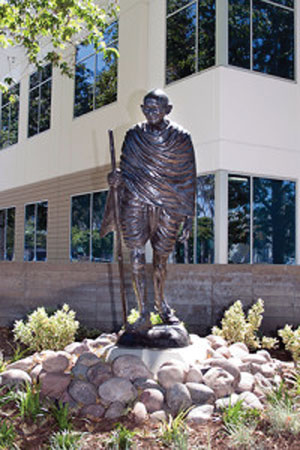When I first moved to Southern California some 30 years ago, as Indian Americans (whether Hindu, Sikh, Muslim, or Christian), we were commonly teased for our brown skins and cultural quirks. The word “Gandhi” was a common pejorative by some in my neighborhood. “Hey Gandhi, you got a big dot on your head.” “Hey Gandhi, get me a slurpee.” It didn’t matter your faith. If you were brown, you were “a Gandhi.”
Fast forward some 30 years later. Today, in Cerritos (the same Southern California town where I grew up), a statue of Mahatma Gandhi was erected. As dot-heads, collectively we had come a long way, I thought.
I was wrong.
In a 6-page letter this past summer, a small fringe group of Indian Americans calling themselves the Organization for Minorities in India (OFMI) and falsely claiming to speak on behalf of all Indian American minorities, demanded that the Cerritos City Council remove the statue on grounds that Gandhi was a repugnant man who had committed many personal transgressions. I was contacted by a larger group of Indian Americans in the city who wanted me to join them in responding to the 6-page letter and explain why the Gandhi statue should remain.
 (Left): A statue of Mahatma Gandhi in Cerritos, Calif., was the source of bitter controversy, even among Indian Americans. The artpiece, created by artist Jasu Shilpi, is a 6-foot-tall bronze statue of Mahatma Gandhi. The statue is elevated on a pedestal and lighted for night-time visibility. [Photo: City of Cerritos]
(Left): A statue of Mahatma Gandhi in Cerritos, Calif., was the source of bitter controversy, even among Indian Americans. The artpiece, created by artist Jasu Shilpi, is a 6-foot-tall bronze statue of Mahatma Gandhi. The statue is elevated on a pedestal and lighted for night-time visibility. [Photo: City of Cerritos]
I agreed to do so, but the first step was to read and distribute OFMI’s 6-page letter to the others. This would allow our group to respond to the points being made. Upon distributing the letter via email to our group, this is the response I received from one Indian American man (I will refer to him here as “Ostrich”):
Why you are doing a dis-service by sending this filthy letter to promote the contents that lot of Indians born in 60, 70, 80 don’t know about such contents. Let dead stay in their graves otherwise it smells pungent.
Putting aside Ostrich’s atrocious grammar, I was confused. Did Ostrich think that I was the author of OFMI’s letter? After re-reading his comment, I realized that wasn’t the case. Ostrich was mad at me for simply sharing the letter with the rest of our group. He didn’t want anyone – including our group – reading the letter. But how do you respond to a letter if you can’t even read it? To be sure, Ostrich wasn’t denying that Gandhi committed personal transgressions. In fact, he acknowledged (rightfully) that Gandhi was not perfect. But Ostrich insisted that it was better to hide any negative “contents” about Gandhi since many Indians did not know about them. Here was my reply:
Dear Ostrich: My help was requested so that we could write to the City Council. In order to respond to the letter that was written, I merely attached it for all of us to read. Putting our heads in the sand merely makes us more ignorant. I am not trying to promote the letter, I am merely sending it to this group so that we can respond to it point by point.
Certainly, logic would ultimately prevail.
Of course, I was wrong again.
Ostrich wrote back:
Plz don’t share letter with those Indians who don’t know. You are damaging the reputation. Shut up and don’t do more harm. Don’t become a damn leader for trash. Do some more social work you old cranky insect.
Enter paranoia. More troubling than the ignorance of non-Indian Americans is the cultural insecurity among Indian Americans. Rather than addressing why Gandhi’s shortcomings shouldn’t disqualify a statue in his honor, Ostrich wanted to keep the shortcomings a secret from the rest of Indian Americans. Not only did he prefer to bury his own head in the sand, and hope the insects went away, he wanted to create an entire colony of Indian Ostriches.
As an “old, cranky insect” (at least 25 years younger than Ostrich), I replied:
Dear Ostrich: I am amazed at how complicated this has turned out for you. In no way do I agree with the letter. But rather than hiding from facts, I think it’s better to talk openly about them.
Ostrich wrote back:
Don’t send any email to me disgusting or I report to AOL and POLICE. Just shut up 100%. Let sleeping dogs sleep. Don’t throw stones on them and they will bite you. Ok mind your other businesses.
Unfortunately for Ostrich, the rest of us didn’t shut up 100%. We didn’t let sleeping dogs sleep, and we decided to throw stones on them and guess what? To Ostrich’s amazement, they didn’t bite us. Instead, after presenting to the City Council clear, balanced, and well-reasoned defenses of Gandhi, even despite his shortcomings, the statue remains in Cerritos. The Indian Ostrich was assuredly vanquished, we thought.
Wrong again.

(Above): A recent GAP advertisement showcasing a Sikh model caused a rift even between Sikh Americans. [Photo: Gap.com]
Enter the super-minority forming Ostrich – and not a penny less paranoid. This past November, GAP’s “Make Love” advertisement showcased a Sikh man (Waris Ahluwalia) and a non-Sikh woman posing in GAP’s winter clothing line. The woman has one hand on Ahluwalia’s chest and the other on his turban. While someone at a New York subway station defaced the poster and made racial slurs over Ahluwalia’s identity, most Indian Americans (Hindu, Sikh, Muslim, Christian alike) celebrated the advertisement for its inclusion of the Indian American community and praised GAP for its support of Ahluwalia even after the defacement.
Notice I said “most Indian Americans.”
Again, a small fringe group of Indian Americans – claiming to represent the entire Sikh community – protested the GAP ad. They claimed the advertisement was offensive to Sikhism and disrespectful because the woman was touching Mr. Ahluwalia’s turban in a sexualized way. They protested outside GAP stores, wrote letters to leaders and businessmen, and encouraged a larger boycott of GAP altogether. On online social forums, they tried to explain why their religious texts forbid such depictions of the turban:
The Fact That This Woman’s Hand Is On This Sikh’s Turban Is Disrespectful Of The Sikh Religion & Sikhs! The Gap ad is totally uncalled for and disrespectful. From the Sikh Gurus time, if anyone touched someone’s ‘dastaar/paag,’ (turban), it was an outright legitimate reason for battle. The ‘dastar’ isn’t an object that anyone can touch whenever one feels like it. The ‘dastar’ is tied in great respect and honor, and thus should be handled in the same manner. Printing thousands of posters with this woman’s hand on a Sikh’s ‘dastar’ gives the message that any westerner can have power over Sikhs by handling a ‘dastar’ in the same way, as if it were a hat or hand rest… Sikhs should not allow a sexy model in this Gap ad to put her hand on the Sikh’s turban!
The Indian Ostrich thrives on cultural insecurity. Its paranoia knows no bounds and borders stupidity. This wasn’t an advertisement denigrating Indian Americans or their religion. It wasn’t an advertisement depicting a god or guru on a toilet seat or a bikini bottom. It was an advertisement of inclusion, educating the rest of America that turbans do not equal terrorism. It was a step forward for a section of our community that has been largely misunderstood. In a single snapshot, the advertisement would reach far more people, and raise far more social awareness, than any Indian American speaker, religious leader, or educator could do in a decade. Yet the Indian Ostrich was at work yet again, ignoring all of these realities.
When we, as Indian-Americans collectively grow up together, when we are called “a Gandhi,” when we are labeled as “dot-heads,” when we are confused for “terrorists,” when we are shot at after 9/11, when we are targeted, stabbed, and killed for fun, when we are discriminated against for wearing “hats,” when we are kicked out of clubs, and planes, and trains, when we are gunned down in our own temples of worship, then we need to realize that we are too small of a community to keep making even smaller.
We need to realize that on the few times when we are assimilated into the larger American fabric – where they build our statues and model our faces – we cannot afford to let those who know the least of our collective culture be our spokespersons. It is ironic that in the West, where we are still slowly assimilating as a collective minority, we are sometimes our own worst enemies. Compare this to India where minorities such as homosexuals, women, and the poor still do not receive basic human rights, even though the Constitution and our traditions require it. We owe it to those minorities to stop being divisive and start uniting our interests and histories.
Wherever the Indian Ostrich, they flourish on preaching gospels of further division and would choose to ignore history, rewrite facts, and keep information away, hoping and praying that when they remove their heads from the sand and finally look up, the rest of us will be gone.
They are wrong.